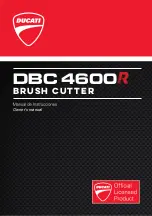
18
CAUTION:
The brake stud may need to be adjusted if there is significant belt wear or if a
different size belt is used. If the brake stud is not adjusted correctly, the blades will still
spin even though the clutch may be in the disengaged position. Always shut mower
engine off before servicing.
Under normal operating conditions the brake stud should require very little adjustment. Periodic
brake stud inspections should be performed. There are two parts to inspecting the brake stud.
Those two inspections are the disengaged spring length and brake stud clearance.
Note:
It is quicker to perform the disengaged spring length and brake stud clearance
inspections if done simultaneously.
Figure 10: Belt Pattern and Spring Adjustment (Model H40B)
Disengaged Spring Length:
This inspection must be performed to make sure that there is proper braking force to prevent the
blades from spinning when the clutch is in the disengaged position. With the clutch in the
disengaged position measure the spring length. The spring must be between 3-1/4” and 4” to
provide the appropriate braking force. If the spring length is over 4” it will be necessary to adjust
the brake stud closer to the belt. If the spring length is less than 3-1/4” it will be necessary to
adjust the brake stud further away from the belt. To make brake stud adjustments loosen the bolt
on the top of the brake stud and slide the brake stud in the slot. When the proper disengaged
spring length is achieved, tighten the bolt on the top of the brake stud. For this procedure do not
adjust the spring length. The spring length should only be changed when adjusting the belt
tension.
No Less Than 1/2” Clearance
With Clutch Engaged
0” With Clutch Disengaged
Brake Stud
Clutch Engaged Spring
Length 2-3/4” to 3-1/4”
Clutch Disengaged Spring
Length 3-1/4” to 4”
Clutch Arm
Engine
Front
Clutch Engagement
Only Include
Spring in
Measurement
Summary of Contents for AcrEase H60B
Page 2: ...cbxcbxcvb...















































